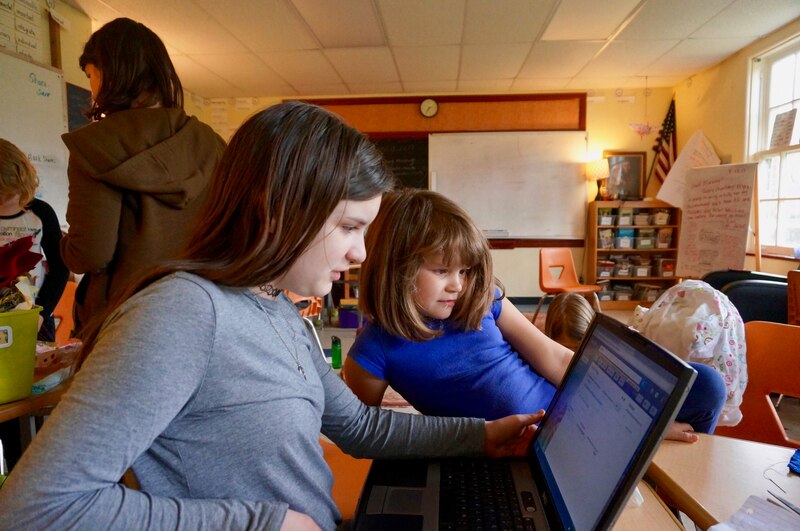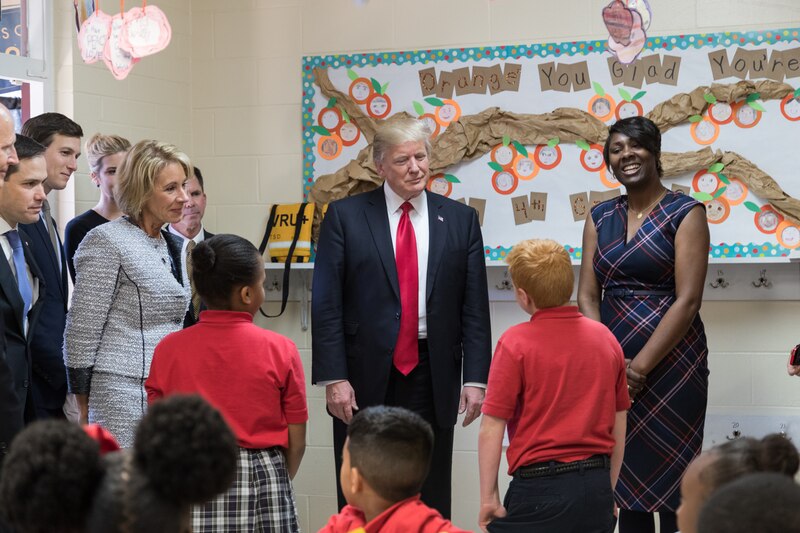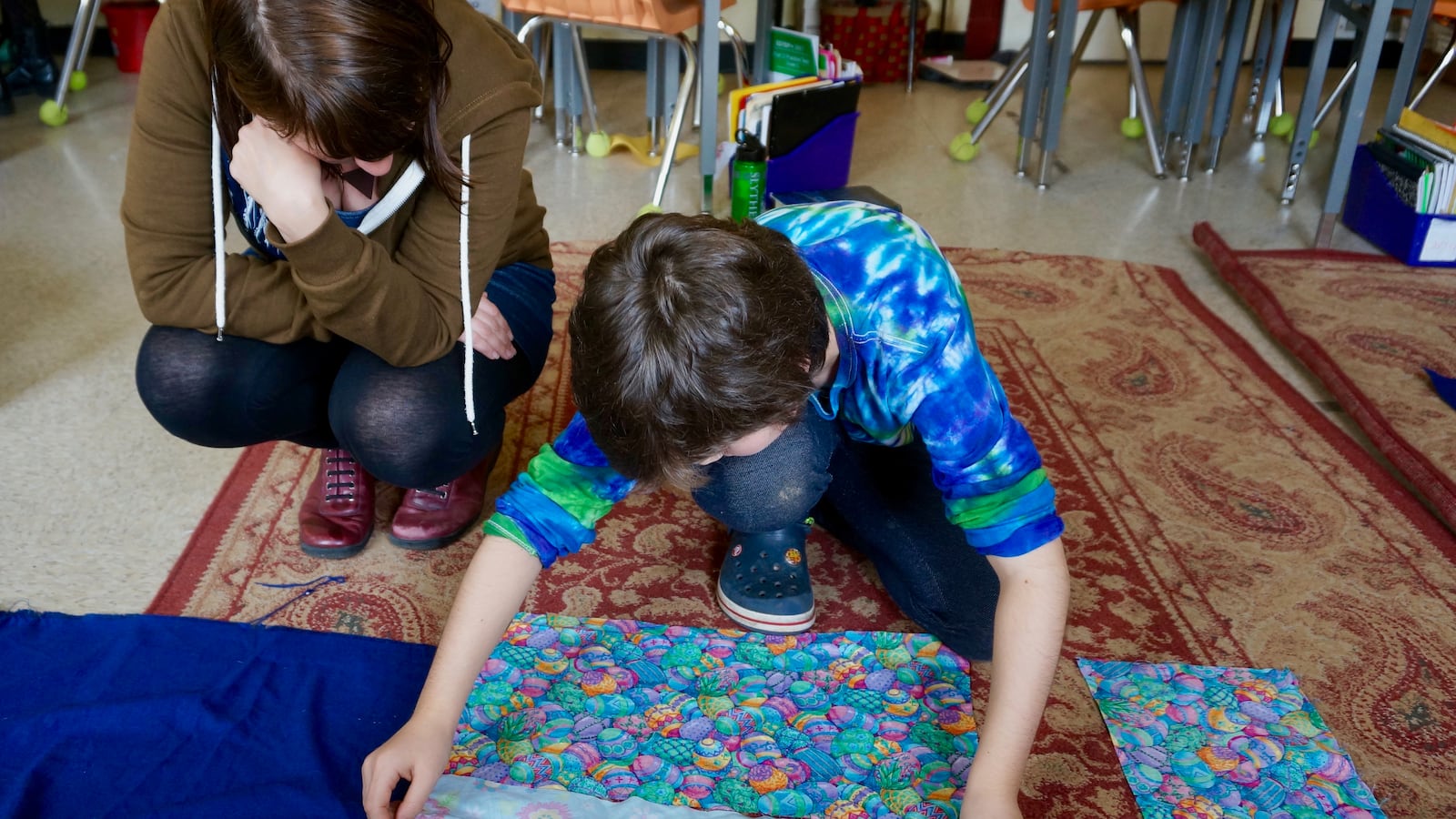Seven-year-old Fallon breathed a sigh of frustration.
Her classmate, 11-year-old Myra, looked across the small round table where they were working. Fallon, sewing a pin cushion, was bent over her needle, struggling to slip thread through its eye.
“Here’s a tip,” said Myra. “You see how this is frayed at the end? … You’ve got to ever-so-carefully snip that frayed edge.”
Fallon and Myra are students at the School for Community Learning, a progressive private school on the north side of Indianapolis, where kids not only take math and reading but also study less conventional topics like sewing, birding and Hogwarts — classes that bring together children from kindergarten through middle school.
The School for Community Learning is unusual among Indiana private schools for not having a religious focus: More than 90 percent of the state’s private schools are religious, compared to 68 percent on average in the U.S.
But even within that small group, it’s notable as one of just seven non-religious private schools participating in Indiana’s expansive school voucher program this year.
Voucher advocates, including current U.S. Education Secretary Betsy DeVos, say they want families to be able to choose from a diverse marketplace of schools. But Indiana’s complicated school choice system offers little incentive for secular schools to take vouchers — leaving largely religious Christian schools benefiting from the state funds.
It works like this: Schools that want to serve poor students but don’t have a religious mission can open as charter schools — and bring in thousands of dollars more per student from the state.
Private schools that are not focused on serving poor students often charge upwards of $20,000 a year, more than four times the average voucher amount, and usually have their own scholarships to hand out.
And private schools with highly unusual approaches might not want to accept the stringent testing requirements that Indiana places on voucher schools.
The result: Of the 313 schools across Indiana that received vouchers this year, 306 are either part of a religious network, such as a Catholic diocese; have overtly religious names; or proclaim their faith on their websites, according to a Chalkbeat analysis. (Indiana doesn’t collect data on whether schools in the voucher program are religious.)
Of the seven voucher-funded schools that appear to be secular, three educate children who’ve struggled in other schools or have specific needs, such as dyslexia. That leaves just four secular private schools that serve typical students.
One of them is the School for Community Learning, whose unusual history offers insights into why there aren’t more schools like it taking vouchers in Indiana.
The school was born from the ashes of a charter school, the Project School, that the Indianapolis mayor’s office closed abruptly five years ago because of financial issues and low test scores. It was July, just weeks before the school year started, and teachers and parents had no idea where to turn.
A handful of teachers and about 25 families decided to start again without the backing of a charter authorizer, opening a private school with a focus on project-based learning. They had no campus, and no idea where they would get money. Parents paid whatever tuition they could afford and teachers barely earned anything, said Megan Howey Hughes, the director of the school.
“Parents also came in and they were the janitors,” she said. “If they couldn’t pay tuition, they did other work.”
After that first, cash-strapped, unsustainable year, everything changed: The school became eligible for the state’s vast new voucher program, and state funds started flowing. (Because of a quirk in Indiana policy, schools were required to operate for a year before receiving vouchers. That changed in recent weeks, when Gov. Eric Holcomb signed a bill that allows new schools to receive vouchers immediately.)
Most people starting non-religious schools don’t grapple with these intricacies. Instead, they’ve gone first to starting a charter school, which brings more state funds, and faster. Thirty-six new charter schools serving traditional-age students have opened in the last five years, according to state data.
In addition to getting more money per student from the state, being a charter school means there’s no perception that tuition could be a barrier. That’s a boon for schools trying to attract low-income parents.
“It would be great to be open to all children for free. That would be terrific,” said Patricia Wildhack, the school leader at School for Community Learning.
But the founders of the school passed up that extra money because they had such a bad experience with their prior charter school. They didn’t want to be under the control of an authorizer.
As a private school, “We get to make decisions from the board level down to the classroom level in a way that allows us even more flexibility,” Hughes said. “We are just us.”
This year, nearly 86 percent of the 70 students at the School for Community Learning are receiving state aid to help their families pay tuition, one of the highest rates in Indiana.
“We didn’t want to give up our belief that our school should be accessible to all students regardless of family income,” Hughes said. “We’re working really hard … to be a private school that’s financially accessible.”

Some private schools are able to make themselves accessible to at least some poor families in other ways — usually by providing scholarships on their own, as the elite Park Tudor School in Indianapolis does. Vouchers would alleviate some of the cost, but at an average of $4,258 per student, would leave a lot to be covered at schools that cost close to $20,000 a year — and come with strings that the schools don’t want.
Plus, some schools are reluctant to welcome low-income students who might not be academically prepared, said Mike Petrilli of the Fordham Institute.
“If you’ve got people spending a lot of money to send their kids to this school, and then all of a sudden you open the doors to kids who are paying nothing,” Petrilli said. “That could be challenging, depending on the school community.”
Voucher advocates say it’s not ideal when thriving private schools with strong academic records steer clear of voucher programs. Jay Greene of the Department of Education Reform at the University of Arkansas said regulations that discourage the schools from joining in could result in students going to lower-quality schools.
“The more you drive quality private schools out of the program,” he said, “the worse the results are going to be.”
Among the rules that could dissuade schools from participating, according to Greene: testing requirements. Indiana’s voucher program has some of the strictest testing rules in the country, requiring schools to administer the state exam not only to students using vouchers but to all students. Low scores could cost the schools the right to state funds.
At the School for Community Learning, preparing kids for the state test can be a burden, said Wildhack. Teachers have to make sure their curricula follow the order outlined in the state standards, and it makes it harder to find time for projects.
If someone suddenly gave the school a few million dollars, they might choose to leave the voucher program. But for now, vouchers are “totally worth it,” Wildhack said.

For some religious schools with a history of serving low and middle-income students, vouchers also help fill crucial budget gaps — and seats — as they face stiff competition from charter, magnet and public schools that don’t cost parents. As in Louisiana, Ohio, and Wisconsin, vouchers in Indiana have helped prop up struggling urban Catholic schools.
One reason vouchers are such a contentious political issue is their entwined relationship with religion. DeVos, a longtime school choice advocate, has called attention to this relationship by visiting several Christian schools that benefit from public money since becoming education secretary.
But the U.S. Supreme Court ruled in 2002 that vouchers don’t violate the constitutional principle of separation of church and state because parents may choose where to use the tuition dollars they receive.
The executive director of Indiana’s private school association said the dearth of secular private schools in the state’s voucher program should not be seen as alarming.
After all, said John Elcesser of the Indiana Non-Public Education Association, from neighborhood public schools, to magnet and charter schools, families have lots of secular options.
“You have to kind of look at the big picture when you look at what are the options available to families,” Elcesser said.
The School for Community Learning is in many ways very different from the religious schools that have benefitted most often from vouchers, prioritizing project-based learning rather than prayer. But there are characteristics that make it similar: It was built around shared values, from a commitment to social and environmental justice to dedication to the community.
It’s been sustained because, like a lot of religious schools, parents and staff are willing to make sacrifices to support those values, Hughes said.
“It’s different enough for them that they are willing to make the drive or pay the money or kind of do what it takes to have their child in this safe space of learning.”

